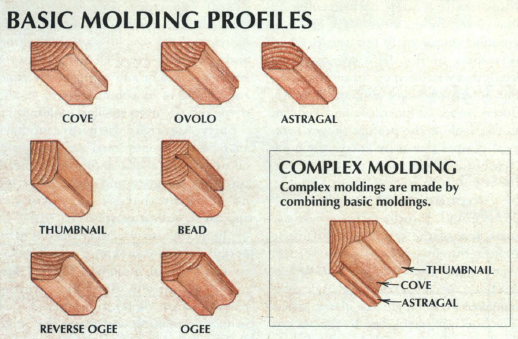We may receive a commission when you use our affiliate links. However, this does not impact our recommendations.
Whether applied or integral, recessed or relieved, mouldings bring style to a structure. Different combinations of these concave and convex surfaces, or profiles, play with light and shadow to create the overall visual effects that define a piece of furniture. Mouldings please the eye by easing transitions between parts and surfaces, by dividing large open areas into subsections, and by refining edges, corners and other borders. The size and overall shape of a moulding can enhance the visual balance or scale of a piece, or even create an illusion of motion.
The use of mouldings in furniture reached its zenith during the 17th and 18th centuries, when cabinetmakers worked by complex rules of form and proportion. Today, cabinetmakers observe these same rules when building reproduction pieces.
Architectural Origins
Cornice, rail, plinth, soffit—these are just a few of the terms that furniture makers borrowed from architecture. Even when cabinetmaking was recognized as a separate craft, apprentice cabinetmakers were taught the classic orders of architecture established by the ancient Greeks and Romans. With each of these orders (Tuscan, Doric, Ionic, Corinthian) mathematical formulas determined the size, location, proportion and profile of every element—from a structure’s height and width to the taper and fluting of its columns—even to the shape and size of its smallest moulding.
Early American furniture makers adapted the proportional and ornamental rules of the classic orders to the furniture they designed and built. Thus it’s no accident that period furniture appears so well-proportioned.
There are also practical reasons why period mouldings on furniture were similar to architectural mouldings on buildings. With a few minor exceptions, the same moulding planes used in carpentry were also used in cabinetmaking. By using the same mouldings as housewrights, cabinetmakers ensured that their work became a part of the room.
Recognizing Period Mouldings
There are 2 sorts of mouldings: simple and complex. There are only a handful of simple profiles and no matter what kind of woodworking you do, it’s worth learning to recognize and identify them by name. (See drawing, above.) Complex mouldings are made up of two or more simple shapes. Combinations of these mouldings are associated with particular furniture periods.
In the pictures below, I’ve selected individual pieces that typify the 4 major period moulding treatments. But it’s important to realize that a great deal of variation can exist within each period. Working within the limits of their eras, Early American craftsmen often took creative license.
 The above information was excerpted from an article written by Mike Dunbar in the August 1995 issue of American Woodworker magazine (#46). Buy all 30 years of AW magazine content on one disc, available in our store.
The above information was excerpted from an article written by Mike Dunbar in the August 1995 issue of American Woodworker magazine (#46). Buy all 30 years of AW magazine content on one disc, available in our store.
–AWE
Here are some supplies and tools we find essential in our everyday work around the shop. We may receive a commission from sales referred by our links; however, we have carefully selected these products for their usefulness and quality.












